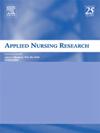Comfort and patient activation in patients with myocardial infarction: A cross-sectional study
IF 2.2
4区 医学
Q1 NURSING
引用次数: 0
Abstract
Aims
To examine comfort and patient activation, affecting factors, and the relationship between comfort and patient activation in patients with myocardial infarction.
Background
Comfort is an important requirement for managing the treatment and patients' well-being and patient activation improves patient engagement. Assessment of comfort, patient activation and associated factors are important to reduce complications and ensure adherence.
Method
This cross-sectional study was conducted between May and August 2023 on 138 patients in the cardiology clinic who met the inclusion criteria. The research data were collected using a Personal Information Form, a General Comfort Scale, and the Patient Activation Measure.
Results
It was determined that 67.4 % of the patients were male, and the mean age of patients was 55.47 ± 13.59 years. Comfort was found to be moderate and patient activation level was in the first stage in 50.7 % of the patients. A relationship was found between comfort and gender, education status, health perception, hospitalization experience and number, complications, having chronic disease and medication use, source of information and symptoms, while education and employment status, regular exercise, having chronic disease and symptoms affected patient activation. There was a significant, positive correlation between comfort and the patient activation.
Conclusions
Comfort and patient activation levels of patients with myocardial infarction are related to sociocultural and disease-related factors. Individualized nursing interventions should be planned in line with the affecting factors to increase comfort and patient activation. Also, controlled studies should be conducted in individuals identified as risk groups are important for clinical applications.
心肌梗死患者的舒适度和患者激活:一项横断面研究。
目的:探讨心肌梗死患者舒适度与患者激活、影响因素及舒适度与患者激活的关系。背景:舒适是管理治疗和患者健康的重要要求,患者激活可提高患者参与度。评估舒适度、患者激活和相关因素对于减少并发症和确保依从性很重要。方法:本横断面研究于2023年5月至8月对138例符合纳入标准的心脏科门诊患者进行。研究数据是通过个人信息表、一般舒适量表和患者激活量表收集的。结果:男性占67.4%,平均年龄55.47±13.59岁。50.7%的患者舒适感为中等,患者激活水平为第一阶段。舒适度与性别、受教育程度、健康感知、住院经历和次数、并发症、患有慢性病和药物使用、信息来源和症状之间存在关系,而教育程度和就业状况、经常运动、患有慢性病和症状影响患者的激活。舒适度和患者激活之间存在显著的正相关。结论:心肌梗死患者的舒适度和患者激活水平与社会文化和疾病相关因素有关。应根据影响因素制定个性化护理干预措施,以增加患者的舒适度和激活度。此外,对照研究应在确定为风险群体的个体中进行,这对临床应用很重要。
本文章由计算机程序翻译,如有差异,请以英文原文为准。
求助全文
约1分钟内获得全文
求助全文
来源期刊

Applied Nursing Research
医学-护理
CiteScore
4.50
自引率
0.00%
发文量
65
审稿时长
70 days
期刊介绍:
Applied Nursing Research presents original, peer-reviewed research findings clearly and directly for clinical applications in all nursing specialties. Regular features include "Ask the Experts," research briefs, clinical methods, book reviews, news and announcements, and an editorial section. Applied Nursing Research covers such areas as pain management, patient education, discharge planning, nursing diagnosis, job stress in nursing, nursing influence on length of hospital stay, and nurse/physician collaboration.
 求助内容:
求助内容: 应助结果提醒方式:
应助结果提醒方式:


